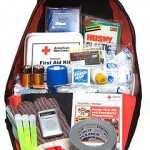I originally started writing this as all one post. Eventually, however, what was to be a simple short article on preparing for disaster turned into almost 8 pages. So, this will be broken up into two or three parts over the next few days. I’m writing this because this site isn’t just about fitness or strength training. Health is an all-encompassing idea that affects every aspect of life. I hope this short guide helps many people, but more so I hope you never have to use it.
- Chris

Photo Courtesy Wikipedia
In light of the abundance of recent disasters to strike major cities around the world, it seems like there has been a growing focus on how to prepare for the worst should it come true (and with good reason). Disasters like the earthquakes in Haiti and Japan, tsunamis and even things like social uprising and riots have brought to our attention the necessity of being ready if and when something goes down. Fortunately, there are a number of things you can do to be better prepared. Among those things are having an emergency preparedness kit and a go bag (or bug out bag). Let’s start with an emergency preparedness kit.
Emergency Preparedness Kit
This is the package of stuff you want to have around your home or shelter for when you are going to stay put. This kit should be stored safely somewhere in your home that is easily accessible. Make clear to members of your household that these are emergency supplies only. It’s a good idea to run through the items in this kit twice a year, when the clocks change (as you should be checking smoke detectors) to make sure everything is still there, working and fresh. Some of the items that should be in your EPK are:
- Non-perishable, ready to eat foods and a manual can opener
- 1 Gallon of drinking water per person, per day
- First Aid Kit
- Flashlight (LED powered flashlights are best. They last longer and are more durable)
- Battery operated AM/FM Radio (or a crank radio that doesn’t require batteries)
- Whistle (In case you become trapped to alert rescue crews to your location)
- Iodine tablets or 1 Quart of unscented bleach (for disinfecting water ONLY if directed to do so by health officials) and eyedropper (for adding bleach to water)
- Personal hygiene items
- Phone that doesn’t rely on batteries
- Other special needs items
Obviously this list isn’t all-inclusive. Any other items you feel might be helpful in an emergency situation where you are hunkering down at home can’t hurt. Some other things I would include are duct tape, a small tool kit, at least 2 forms of fire starting equipment and spare batteries of various sizes. You can never be too prepared.
Check back for the next part in this series for information on assembling a bug out / go bag and planning in the event of a disaster.